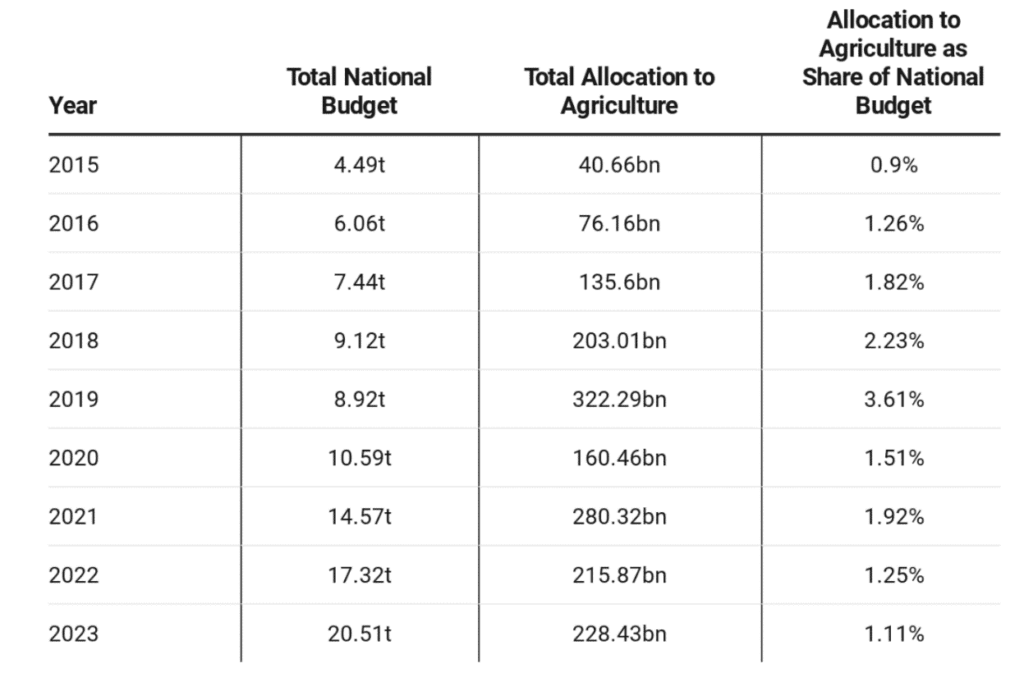The Nigerian economy had been largely dependent on its agricultural sector before the discovery of oil in 1953. The sector contributed about 60% of the nation’s GDP, provided employment opportunities, ensured food security, offered raw materials for manufacturing industries, and generated revenue (foreign exchange) for the nation while also serving as a source of farmer income[3]. In 2023, the Notre Dame Global Adaptation Initiative Index[4], which assesses the vulnerability of countries to climate change ranked Nigeria 160th out of 181 countries showing the country’s status regarding its vulnerability to the impact of climate change. This can be partly attributed to Nigeria’s geographical location because of its extended coastal line along the Gulf of Guinea thereby largely exposing the country (mostly the southern regions) to sea-level rise, coastal erosions, and storm surges.

Fig 1. Nigeria’s Agricultural Budget Allocation from 2015 to 2023 (Dataphyte)
Food Security
According to the Global Food Security Index in 2022, Nigeria ranked 107th out of 113 countries, indicating the severity of the state of food insecurity in Nigeria[5]. A major factor that has contributed to this is reduced crop yield and other agricultural produce which can be traced to the impact of climate change. Variations in the pattern of rainfall especially in the southern regions and widespread desert encroachment in the northern regions have resulted in the inhibition of crop development, loss of soil fertility, and arable land with the aftermath of these effects ultimately being a significant decline in agricultural productivity. This situation has escalated to food scarcity, giving rise to food prices. Nigeria boasts a large agricultural land area of approximately 69 million hectares, with an arable portion of about 34 million hectares. This region has a rich and varied agroecology that supports the cultivation of most agricultural produce consumed in the country. Most of Nigeria’s rural inhabitants, about 97 million people or 48% of the national population, earn their livelihoods as smallholder farmers. They farm plots of less than 2 hectares and account for around 70% of the total farming population. Surprisingly, these small-scale farmers are responsible for producing up to 90% of Nigeria’s national agricultural output. This indicates the lack of adequate capacity of the sector to produce food on a large scale. An example of this was a decline in cereal production by 4.24% in 2020. This reduction can be attributed to a decrease of 1.54% in cereal yields and 2.75% in cereal areas harvested[6]. This trend has led to a decrease in the overall output of cereals, which significantly impacts the food industry and the economy.

Fig 2. The trend of Food Security and Population Growth in Nigeria (Aiyedogbon et al., 2022)
Socio-economic Impact
The poverty state of Nigeria starkly differs from its wealth of human and natural resources. The poverty rate has consistently been on the increase and in 2019, Nigeria was ranked as the country with the second highest poverty rate globally after India[7]. Nigeria’s poverty rate has increased from 40% to 46% which translates to people living in poverty rising from 79 million to 104 million[8] These numbers spotlight the domino effect climate change has on the economy, especially the agricultural sector. The low yield of crops and other agricultural produce diminishes the income farmers generate, especially those who depend on agriculture for their livelihoods thereby rendering them unable to cater to their basic needs. The National Bureau of Statistics, in 2019 reported that an estimated sum of N22.8 trillion was spent by Nigerians on food portraying 56.7% of the aggregate household expenditure of about N40.2 trillion. This shows how an increase in the prices of food due to food shortage in the country has disproportionately affected low-income households who expend a substantial portion of their income on food. Higher prices of food often influence individuals or families to apportion more of their budget to food while being left with little to afford other necessities. With the unstable and incommensurate income value of the majority of the population and price hikes in food commodities, food insecurity has escalated more than ever.
Nigeria’s labour market witnesses a steady influx of new entrants every year, with roughly 2.5 million individuals joining the workforce annually. Interestingly, the majority of these new entrants are young people, constituting approximately 60% of the total workforce[9]. Numerical data from the World Bank’s development indicators repository[10] has shown that employment in Nigeria’s agricultural sector accounted for about half (52%) of the total population in 1991 but has been on a downward trend to about 38% of cumulative employment in 2022. For most rural communities in Nigeria, agriculture is their primary source of employment and by extension the major source of income generation. The consequence of climate change resulting in flooding, desert encroachment, and insecurity (communal conflicts) has either caused most of the rural dwellers to migrate to urban centers or desist from engaging in farming activities for the preservation of their lives. The long-term effect of this is a rise in the level of unemployment, especially in the agricultural sector. While this affects the smallholder farmers, companies and industries providing agro-related services also experience ripple effects as their operations are affected by these factors.
The impact of climate change on Nigeria’s agricultural sector cannot be trivialized as it has a critical influence on the socio-economic development trajectory of the nation. In light of recent developments globally, challenges posed by climate change have exposed weak sectors within the economies of countries especially those that fall within the global south which has led to an increase in food insecurity, unemployment, and poverty among others. Some of the sectors that have been exposed as a reason of the effects of climate change include; energy, agriculture, transportation, health, and education. Combating these challenges requires an innovative and methodical approach with the primary objective of providing a scalable and sustainable solution for the long term.

Fig 3. Employment in Agriculture in Nigeria’s Workforce Distribution (World Bank Data)
Way out of the Woods
With the global dynamics caused by climate change, especially in Nigeria’s agricultural sector, it is imperative to address the situation proactively. Strategic solutions to the matter at hand would require ample collaborative efforts while engaging the tools of policy, partnerships (both local and international), and technology. These approaches would ensure a structural and institutional change that would help salvage the current state of the sector.
Recommendations for Policy Reforms
- Research and Development Funding: The total allocation to agriculture as a share of the national budget from 2015 to 2023 averages 1.73% which is critically below the Maputo declaration which adopts that at least 10% of the national budget should be allocated to agriculture and rural development. More budgetary allocations should be invested in research and development in Nigeria’s agricultural sector. This means supporting entities such as government research institutions, organizations, and academic institutions in learning and exploring potential options such as developing climate-resilient crop varieties, drought-resistant seeds, and innovative agricultural technologies through collaborations and partnerships with other countries which will enhance the development of the sector while leveraging technology as a tool.
- Policy Coherence and Integration: The adverse effects of climate change cannot be isolated to the agricultural sector alone as others such as the energy and environmental sectors have been affected as well. The interconnectedness of these sectors therefore requires a synergy and integration of reformative policies in these industries to complement one another to achieve long-term and more sustainable results.
- Strengthening Governance and Institutions: The ineffectiveness of the accountability mechanisms and systems of the country over the years has inevitably given rise to corrupt practices in every other sector. The mismanagement of public funds in Nigeria’s agricultural sector has jeopardized the implementation of transformative policies by the government to develop the sector over the years. Accountability institutions must be afforded the necessary support financially, administratively, and legally to hold individuals or institutions accountable and also ensure budget credibility as touching all of their operations both at the national and sub-national levels.
- Reduction of interest rate on agricultural loans: With about 90% of production in Nigeria’s agricultural sector dominated by small-scale farmers who are grappling with the socio-economic realities of a rise in the level of inflation leaving a majority of farmers with little or no resources to engage in farming activities, the government should consider reducing interest rates on agricultural loans and granting subsidies to farmers. This would encourage agricultural businesses to stay afloat while also stimulating agricultural production across all levels.
- Improved security: A major impact of climate change in Nigeria is the scarcity of natural resources like vegetative land and water. This has given rise to communal clashes especially between herders migrating from the northern regions in search of water and pasture for their cattle to graze and farmers in the southern region which has led to loss of lives and livelihood. It has become a major security concern alongside continuous terrorist activities and banditry across the country. Addressing this particular concern would encourage agricultural activities and also attract foreign investments to help improve the sector. Also, land-use planning and regulation can potentially de-escalate these security concerns by establishing zoning regulations while delineating areas for agriculture, grazing, and settlements, preventing encroachment and conflicts over land use.
- Stakeholders’ engagement and inclusion: The government through relevant ministries, departments, and agencies should collaborate with non-state actors including civil society organizations and the media to further increase engagements with stakeholders (citizens and investors) in Nigeria’s agricultural sector. This approach would provide the opportunity for government to better understand the realities of these socio-economic impacts and how to formulate and implement policies to address them. This approach can also be leveraged to implement programs on farmer education, outreach projects, and other training programs to develop the skills of stakeholders (mostly rural-based farmers) to navigate the impact of climate change.
Recommendations for Technology Integration
- Enhanced Processing and Storage: The Nigerian government should explore the use of renewable energy in the agricultural sector on a large scale. This could potentially solve the challenges posed by inconsistent power supply which has been a major limiting factor, especially for the preservative and supply operations of the sector. Infusing technology-enabled processing and storage facilities will reduce produce degradation and harvest wastage by enhancing food conservation which will potentially improve the adaptability of farmers to climate change impacts and boost their revenue prospects.
- Climate Monitoring and Forecasting: The Nigerian Meteorological Agency (NiMet) should be supported by the government in adopting advanced weather tracking technologies including remote sensing data, meteorological stations, and climate simulation software that can provide real-time and accurate data on weather patterns and climate change trends. Insights deduced from these data would enable farmers to make educated decisions on crop selection, water resource allocation management, and cultivation period.
- Water Resource Allocation Systems: Exploring automated irrigation systems and water management technologies such as micro-irrigation systems, soil moisture monitoring devices, and rainwater catchment systems can improve the efficiency of water consumption and water loss in agriculture particularly in the northern regions experiencing water scarcity due to climate change.
Footnotes
[1] https://www.researchgate.net/publication/26456689_The_Agricultural_Sector_and_Nigeria%27s_Development_Comparative_Perspectives_from_the_Brazilian_Agro-Industrial_Economy_1960-1995
[2] https://www.iosrjournals.org/iosr-javs/papers/vol2-issue2/L0226069.pdf
[3] Chapter 5 : Food Security — Special Report on Climate Change and Land (ipcc.ch)
[4] https://gain.nd.edu/our-work/country-index/
[5] Actionable solutions to food insecurity (punchng.com)
[6] https://www.afdb.org/en/documents/nigeria-country-food-and-agriculture-delivery-compact.
[7] https://blogs.worldbank.org/en/opendata/half-world-s-poor-live-just-5-countries#:~:text=The%205%20countries%20with%20the,Congo%2C%20Ethiopia%2C%20and%20Bangladesh.
[8] https://documents1.worldbank.org/curated/en/099730003152232753/pdf/P17630107476630fa09c990da780535511c.pdf
[9] https://papers.ssrn.com/sol3/papers.cfm?abstract_id=2884934
[10] https://data.worldbank.org/indicator/SL.AGR.EMPL.ZS?end=2010&locations=NG&start=1991&view=chart%20[Accessed%2020%20Mar.%202024]
Author: Gbemileke Kolawole, Program Officer at PLSI
Contributor: Bukola Omotosho
Featured Photo Credit: WFP/Rein Skullerud

